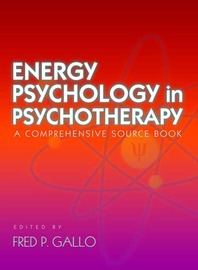
Energy Psychology in Psychotherapy
A Comprehensive Source Book
12 November 2002
Territory Rights — Worldwide.
Description
This is the first book to provide a complete overview of the burgeoning field of energy psychology.
Fred Gallo, the originator of energy diagnostic and treatment methods (EDxTM), has gathered here a stellar group of major participants in the energy field, and the wide-ranging chapters cover enormous ground.
Gallo's introduction discusses a paradigm shift, rooted in physics, that views psychological function and dysfunction from the standpoint of bioenergy factors. This new view challenges prevalent psychological theories that focus on behavioral, cognitive, neurological, systemic, or chemical parameters to the exclusion of the underlying energetic component. This graceful introduction lays the ground for all the chapters that follow.
Part One provides an overview of the major approaches to energy psychology and covers thought field therapy; energy diagnostic and treatment methods; the Tapas acupressure technique and its roots in energy healing in traditional Chinese medicine and yoga; Judith Swack's holistic system that simultaneously addresses the somatic, psychological, and spiritual aspects of an issue; and Larry Nims's BE SET FREE FAST, which has transitioned from meridian tapping to a method that simply uses a cue word or phrase to promote healing. Also discussed are Seemorg matrix work, which synthesizes energy psychology, trauma work, analytical psychology, self psychology, and spiritual principles; and dynamic energetic healing, which combines meridian therapies, manual muscle testing, and regression to the energetic origins of a client's issue. Part Two covers integrative approaches that combine modalities into a unified plan. These include the integration of biofield and chakra concepts, the use of hypnotic language and techniques, and the use of EMDR.
Part Three takes the reader into the session, as clinicians present theories in the context of specific cases and presenting problems. Here, contributors discuss issues such as eating disorders, phobias, traumas, and various other psychological maladies. In the final part of the book, contributors propose highly speculative and creative ideas about the relationship of psychological issues and the possibilities of energy healing. Here, contributors write about behavioral kinesiology and neuropsychological research; galvanic skin response for the exploration and observation of feelings; and the reorganization of energy patterns via psychotherapeutic interventions.
This book is a bold effort to bridge gaps between mind and body, between matter and energy, and between theoretical solutions and the findings of established science. Whether you are a clinician well-versed in energy psychology and want to learn more about a new system, or whether you are new to the whole field, you are certain to find valuable information and insights here.
Gallo's introduction discusses a paradigm shift, rooted in physics, that views psychological function and dysfunction from the standpoint of bioenergy factors. This new view challenges prevalent psychological theories that focus on behavioral, cognitive, neurological, systemic, or chemical parameters to the exclusion of the underlying energetic component. This graceful introduction lays the ground for all the chapters that follow.
Part One provides an overview of the major approaches to energy psychology and covers thought field therapy; energy diagnostic and treatment methods; the Tapas acupressure technique and its roots in energy healing in traditional Chinese medicine and yoga; Judith Swack's holistic system that simultaneously addresses the somatic, psychological, and spiritual aspects of an issue; and Larry Nims's BE SET FREE FAST, which has transitioned from meridian tapping to a method that simply uses a cue word or phrase to promote healing. Also discussed are Seemorg matrix work, which synthesizes energy psychology, trauma work, analytical psychology, self psychology, and spiritual principles; and dynamic energetic healing, which combines meridian therapies, manual muscle testing, and regression to the energetic origins of a client's issue. Part Two covers integrative approaches that combine modalities into a unified plan. These include the integration of biofield and chakra concepts, the use of hypnotic language and techniques, and the use of EMDR.
Part Three takes the reader into the session, as clinicians present theories in the context of specific cases and presenting problems. Here, contributors discuss issues such as eating disorders, phobias, traumas, and various other psychological maladies. In the final part of the book, contributors propose highly speculative and creative ideas about the relationship of psychological issues and the possibilities of energy healing. Here, contributors write about behavioral kinesiology and neuropsychological research; galvanic skin response for the exploration and observation of feelings; and the reorganization of energy patterns via psychotherapeutic interventions.
This book is a bold effort to bridge gaps between mind and body, between matter and energy, and between theoretical solutions and the findings of established science. Whether you are a clinician well-versed in energy psychology and want to learn more about a new system, or whether you are new to the whole field, you are certain to find valuable information and insights here.




